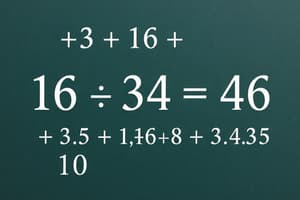Podcast
Questions and Answers
Which expression is NOT equivalent to the sum $48 + 72$?
Which expression is NOT equivalent to the sum $48 + 72$?
- 12(4 + 8)
- 3(16 + 18)
- 8(6 + 9) (correct)
- 4(12 + 18)
Which expression is equivalent to the total number of flowers Jennifer is using to make bouquets?
Which expression is equivalent to the total number of flowers Jennifer is using to make bouquets?
- 5(5 + 9) + 3
- 25 + 3(9 + 5)
- 5(5 + 9 + 3) (correct)
- 25 + 5(9 + 5)
Which expression is equivalent to $(45 + 15) ÷ 12$?
Which expression is equivalent to $(45 + 15) ÷ 12$?
- 9·5 + 3·5 ÷ 3·2·2
- 60 ÷ 3 · 4
- (2 · 2 · 3 · 5) ÷ (2 · 2 · 3) (correct)
- (2 · 2 · 3 · 5) ÷ 4 · 3
Which statement shows the correct prime factorization for the number provided?
Which statement shows the correct prime factorization for the number provided?
What is the product of $8 × 35$?
What is the product of $8 × 35$?
What is the prime factorization of 112?
What is the prime factorization of 112?
What is the prime factorization of 320?
What is the prime factorization of 320?
When will Shane and Terrence get their hair cut on the same day again, given Shane cuts every 6 weeks and Terrence every 8 weeks?
When will Shane and Terrence get their hair cut on the same day again, given Shane cuts every 6 weeks and Terrence every 8 weeks?
Flashcards are hidden until you start studying
Study Notes
Factors and Multiples
- Understanding factors and multiples is crucial in mathematics for simplifying expressions and solving equations.
- Different expressions may represent the same numerical values, emphasizing the importance of equivalent expressions.
Multiple-Choice Questions Insights
- Equivalent expressions for the sum 48 + 72 include different combinations of multiplication and addition.
- Key focus on expressions combining factors to ensure their sums match the original expression.
Flower Bouquet Problem
- Jennifer's total flower count can be expressed in multiple equivalent forms using addition and multiplication to combine totals.
Prime Factorization
- Prime factorization involves breaking down a number into its basic prime numbers.
- Example from the assessment shows the importance of identifying missing factors in a given product.
Correct Prime Factorization
- Statements must accurately reflect the prime factorization of provided numbers, focusing on correct base and exponent representation.
Distributive Property
- The Distributive Property assists in reordering and simplifying expressions for calculations, important for modeling and verifying area in rectangles.
Factor and Expression Transformation
- Transforming factors into sums with no common factors highlights the versatility of multiplication and addition relationships in expressions.
Prime Factor Trees
- Creating factor trees is a method for visually simplifying numbers into their prime factors to ease calculation processes.
Greatest Common Factor (GCF)
- Determining the GCF of two numbers using their prime factorizations reveals shared factors, crucial in simplifying fractions and finding common denominators.
Haircut Scheduling Problem
- The scenario involving Shane and Terrence highlights the use of least common multiples (LCM) to determine future overlapping events based on individual schedules.
Application in Toy Manufacturing
- Understanding groupings and multiplying factors can be applied in real-world contexts such as packaging and manufacturing, illustrating the practical side of mathematical concepts.
Studying That Suits You
Use AI to generate personalized quizzes and flashcards to suit your learning preferences.




